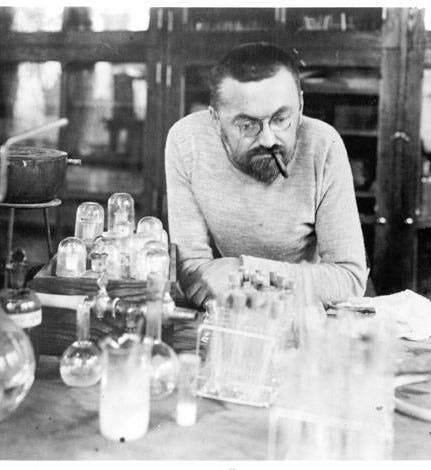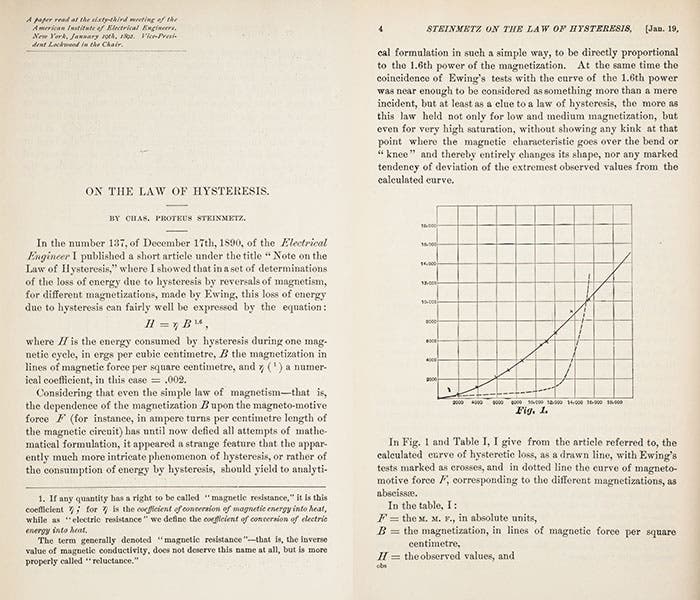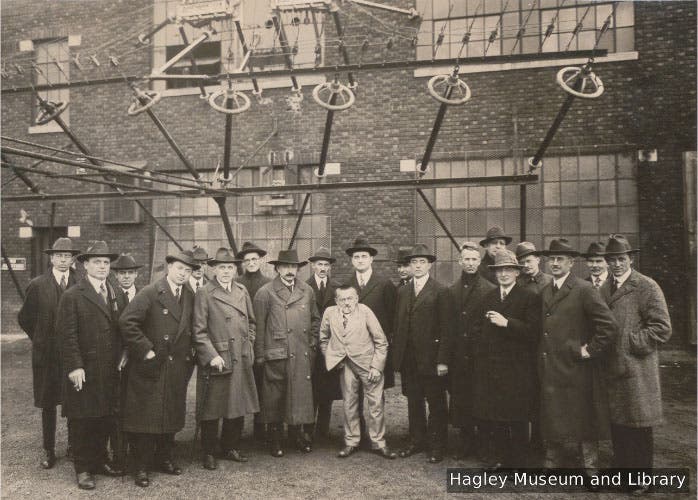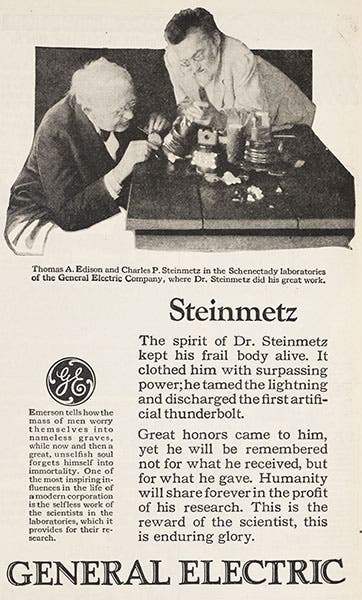Scientist of the Day - Charles Steinmetz
Carl August Rudolph Steinmetz, an electrical engineer, mathematician, and industrial researcher, was born on April 9, 1865. He grew up in the German city of Breslau (present-day Wrocław, Poland) and eventually enrolled in the local university, where he excelled in physics and mathematics. Steinmetz originally intended to pursue a doctorate, but rising debts and persecution for his socialist political views forced him to leave Breslau in the spring of 1888. After a brief stay in Zurich, he booked passage on a steamship to New York.
Steinmetz found a job as a draftsman at Eickemeyer & Osterheld, a small engineering firm in Yonkers that manufactured electric motors. Most of this equipment ran on direct-current (DC) electricity, but Steinmetz became involved in an effort to create an alternating-current (AC) motor for use in streetcars. Nikola Tesla had recently demonstrated a functional AC motor, but it had trouble moving heavy loads from a standstill.
During this research, Steinmetz made an important theoretical breakthrough by crafting an equation that predicted the amount of energy lost in a piece of electrical equipment due to hysteresis—a material’s tendency to resist being magnetized or demagnetized. He published his new “law of hysteresis” in a Dec. 1890 issue of Electrical Engineer and expanded upon his findings in the Transactions of the American Institute of Electrical Engineers (second image). By that time, he had adopted a new American name: Charles Proteus Steinmetz. (His university classmates had previously nicknamed him “Proteus,” a reference to the wise, shapeshifting sea god from Greek mythology who, like Steinmetz, possessed a hunchback in his true form.)
The publication of Steinmetz’s law (as it came to be known) and several subsequent papers analyzing the behavior of AC circuits attracted attention from both his fellow engineers and the leadership of the General Electric Company, which bought out Eickemeyer & Osterheld in 1892. The following year, he joined GE’s staff, first as a member of the company’s Calculating Department and later as a consulting engineer at the firm’s headquarters in Schenectady, New York. In this new role, Steinmetz oversaw the development of GE’s AC motors, transformers, and power transmission systems, eventually earning over 200 patents (third image). He wrote several influential textbooks and received a part-time appointment as head of the electrical engineering department at nearby Union College.
Beyond these technical achievements, Steinmetz also left a lasting mark on the organization of industrial research in the United States. In 1900, he submitted a proposal to his superiors at GE, arguing that if the company wished to retain its dominant position in the electric lighting market, it needed to create a space that would be insulated from the day-to-day demands of commercial product development. There had been earlier industrial laboratories in the United States, most notably Thomas Edison’s famous workshops at Menlo Park and West Orange, but these were focused on product development rather than research into new scientific phenomena. With guidance from Steinmetz and its first director Willis Whitney, the General Electric Research Laboratory would soon show that sophisticated science could emerge from within the confines of a corporate lab. (Indeed, one of the new lab’s earliest recruits, Irving Langmuir, would later win the Nobel Prize in Chemistry.)
Steinmetz’s reputation soared during the early years of the 20th century. With support from GE’s public relations team, Steinmetz actively cultivated a public persona as an eccentric genius, whose unusual appearance concealed a brilliant intellect. Newspapers were filled with stories of the “Modern Jove” who conducted experiments in his home laboratory (first image) in between canoe trips on the Mohawk River. His newfound celebrity also brought him into contact with many other prominent scientists and engineers. On one noteworthy occasion in April 1921, he posed for a photograph at a Radio Corporation of America (RCA) transmission station in New Jersey along with his GE associate Irving Langmuir, RCA commercial manager (and future chairman) David Sarnoff, and special guest Albert Einstein, who was touring the United States for the first time (fourth image).
Another inventor who ran in the same circles as Steinmetz was Thomas Edison. The two men embraced different approaches towards electrical experimentation; Edison was far less inclined toward mathematics than his younger colleague. Nevertheless, the two shared a mutual respect for one another, and GE went out of its way to publicize any meetings between the Wizards of Menlo Park and Schenectady. Even after Steinmetz passed away in the fall of 1923, the company was eager to highlight their professional ties (fifth image).
Through his embrace of theory and efforts to cultivate closer connections between academic and corporate research, Charles Steinmetz transformed what it meant to professional engineer in the United States. Today he is the namesake of an annual award that is bestowed by the Institute for Electrical and Electronic Engineers (IEEE) to an individual who has made exceptional contributions to the development of electrical standards. Union College, where he held a faculty appointment until his death, also hosts a distinguished lecture series in his honor.
Benjamin Gross, Vice President for Research and Scholarship, Linda Hall Library. Comments or corrections are welcome; please direct to grossb@lindahall.org.










